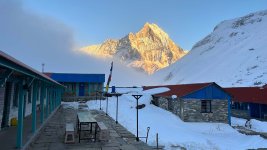
Annapurna Base Camp trek is renowned for its breathtaking scenery and cultural immersion, requires thoughtful preparation to ensure safety and enjoyment. This journey takes you from the vibrant city of Pokhara through the heart of the Annapurna region, showcasing diverse landscapes, traditional villages, and majestic peaks. To help you navigate this adventure while minimizing the risk of altitude sickness, here's a comprehensive guide.
Understanding Altitude Sickness
Altitude sickness is a concern for trekkers venturing above 2,500 meters. Symptoms range from headache, nausea, and fatigue to more severe conditions. It results from the body's difficulty in adapting to lower oxygen levels at high elevations. A gradual ascent and proper acclimatization are crucial to mitigate risks.
Daily Itinerary and Elevation Gain
Your trek starts from Pokhara, and the standard itinerary from pokhara is 7 days, sitting at an elevation of 820 meters, ascending to Annapurna Base Camp at 4,130 meters. Key elevation gains include a trek from Pokhara to Sinuwa (1,520m gain), Sinuwa to Deurali (860m gain), and Deurali to Annapurna Base Camp (930m gain). This path ensures gradual acclimatization, with the journey taking you through breathtaking landscapes and traditional Gurung villages.
Acclimatization Tips
- Start Slow: Begin your trek with shorter distances and lower elevations, gradually increasing both as you acclimate.
- Hydrate: Drink plenty of fluids. Dehydration can mimic or exacerbate altitude sickness symptoms.
- Diamox: Consider discussing with your doctor the possibility of taking Diamox (Acetazolamide) to aid in acclimatization.
- Rest Days: Incorporate rest days into your trek, especially after significant elevation gains, to allow your body to adjust.
Preventive Measures
- Know the Symptoms: Familiarize yourself with the symptoms of altitude sickness. Early detection is key to managing and mitigating severe effects.
- Listen to Your Body: If you experience symptoms, don’t push further. Rest or descend to a lower altitude.
- Travel Insurance: Ensure your travel insurance covers high-altitude trekking and possible helicopter evacuation.